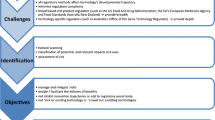Abstract
This article uses lessons from biotechnology to help inform the design of oversight for nanobiotechnology. Those lessons suggest the following: first, oversight needs to be broadly defined, encompassing not just regulatory findings around safety and efficacy, but also public understanding and acceptance of the technology and its products. Second, the intensity of scrutiny and review should reflect not just risks but also perceptions of risk. Finally, a global marketplace argues for uniform standards or commercially practical solutions to differences in standards. One way of designing oversight to achieve these purposes is to think about it in three phases—precaution, prudence, and promotion. Precaution comes early in the technology or product’s development and reflects real and perceived uncertainties. Prudence governs when risks and hazards have been identified, containment approaches established, and benefits broadly defined. Transparency and public participation rise to the fore. The promotional phase moves toward shaping public understanding and acceptance and involves marketing issues rather than safety ones. This flexible, three-phase approach to oversight would have avoided some of the early regulatory problems with agricultural biotechnology. It also would have led to a more risk-adjusted pathway to regulatory approval. Furthermore, it would avoid some of the arbitrary, disruptive marketing issues that have arisen.
Similar content being viewed by others
References
Buttel F (1999) Agricultural biotechnology: its recent evolution and implications for agrofood political economy. Sociolog Res Online 4. http://www.socresonline.org.uk/socresonline/4/3/buttel.html. Accessed 24 Nov 2010
Gruere GP, Carter CA, Farzin YH (2008) What labelling policy for consumer choice? The case of genetically modified food in Canada and Europe. Can J Econ 41:1472–1497
Hanrahan CE (2010) Agricultural biotechnology: the U.S.–EU dispute. Congressional Research Service, Washington
Hoban TJ (1998) Trends in consumer attitudes about agricultural biotechnology. AgBioForum 1:3–7
Kuhn A, Wehrheim P (2002) A quantitative analysis of EU eastern enlargement. Institute of Agricultural Policy. Market Research and Economic Sociology, Bonn
Moore JA (2001) Frankenfood or doubly green revolution: Europe v. America on the GMO debate. In: Teich AH, Nelson SD, McEnaney C, Lita SJ (eds) AAAS Science and Technology policy yearbook 2001. AAAS, Washington
Nestle M (1996) Allergies to transgenic foods—questions of policy. N Engl J Med 334:726–728
Phillips PWB, McNeill H (2002) Labelling for GM foods: theory and practice. In: Santaniello V, Evenson RE, Zilberman D (eds) Market development for genetically modified foods. CABI Publishing, New York
Runge CF (1988) The assault on agricultural protectionism in the multilateral trade negotiations. Staff paper series, Institute of Agriculture Forestry and Home Economics. University of Minnesota, Minneapolis
SeedQuest (2007) European GM regulations impede the improvement of crops in the developing world. http://www.seedquest.com/News/releases/2007/february/18520.htm. Accessed 24 Nov 2010
Weintraub A (2003) The outcry over “Terminator” genes in food. Bloomberg Businessweek. http://www.businessweek.com/magazine/content/03_28/b3841091.htm. Accessed 24 Nov 2010
Acknowledgments
Preparation of this article was supported by National Science Foundation (NSF) grant #0608791, “NIRT: Evaluating Oversight Models for Active Nanostructures and Nanosystems: Learning from Past Technologies in a Societal Context” (Principle Investigator: S. M. Wolf; Co-PIs: E. Kokkoli, J. Kuzma, J. Paradise, and G. Ramachandran). The views expressed are those of the author and do not necessarily reflect the views of NSF.
Author information
Authors and Affiliations
Corresponding author
Rights and permissions
About this article
Cite this article
Johnson, R.S. Governing nanobiotechnology: lessons from agricultural biotechnology regulation. J Nanopart Res 13, 1467–1476 (2011). https://doi.org/10.1007/s11051-011-0252-z
Received:
Accepted:
Published:
Issue Date:
DOI: https://doi.org/10.1007/s11051-011-0252-z



